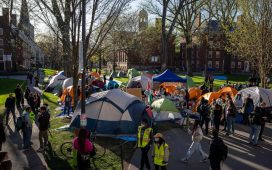
The slow response of Israeli forces on Saturday, a national holiday, gave Hamas terrorists many hours to infiltrate more than 20 towns outside Gaza, where they killed at least 1,200 people and took an estimated 150 hostages.
Israeli officials declined to answer questions about the timing of their response to the attacks. Here’s what we know about the timeline of some of the deadliest events and the official response, based on interviews with survivors and their family members, and an analysis of photos and video.
Before the attacks
Before 6:30 a.m. Israeli intelligence detected an unusual surge in activity on the Gazan militant networks it monitors and alerted the Israeli soldiers guarding the Gazan border.
But the warning wasn’t acted upon, either because the soldiers didn’t receive the alert or the soldiers didn’t read it. Start of attacks Around 6:30 a.m. The deadliest attacks in Israel‘s history started in many places at the same time. Armed paragliders took off from Gaza. Militants used drones to destroy Israeli surveillance stations and began to fire thousands of rockets. Commandos in trucks and on motorbikes sped into southern Israel.
The rockets lit up the dawn sky at an all-night festival, and concertgoers began to evacuate.
A group of students in Nir Oz went into shelters. They would not be rescued for nearly 12 hours.
Shirley Okev went to a safe room in Kfar Aza, a nearby village. She would not leave for more than 20 hours. She contacted her son to alert the army. “But the army didn’t come fast, we waited for a long time,” she said.
6:31 a.m. The Israeli military’s response to the rockets was immediate, but it said nothing of a ground invasion.
6:35 a.m. In Alumim, Sarit Kurtzman heard rocket sirens and rushed into her safe room with her 14-month-old baby. She would stay there for 26 hours until help arrived.
30 minutes after attacks began
7:04 a.m. As Hamas assailants swept through multiple towns, Arie Itzik, a retired nurse who was sheltering in Nir Oz, received a call for help from a woman who had gone out for a walk. Militants had shot her and her husband, she told him. She was wounded and thought her husband was dead. She would later be kidnapped, Itzik said.
Itzik would shelter for at least eight more hours before soldiers arrived to rescue him.
“The army wasn’t in the area, not even one soldier,” he said. “We were all by ourselves. It was terrifying.”
An hour after attacks began
Around 7:30 a.m. By now, many civilians had been killed in towns around the Gaza border, including in Sderot, where gunbattles were ongoing.
Gunshots rang out as panicking festival attendees exiting the event were stuck in traffic. “That was the first moment we understood we were really under a colossal attack,” said Almog Senior, a student at Ben-Gurion University.
Many attendees fled their cars and ran across fields. Senior and his friends drove off-road in an attempt to reach safety.
7:40 a.m. The Israeli military reported that Hamas militants had crossed the border and urged civilians to stay in their homes. But people at home were in grave danger.
7:52 a.m. “I have a lot of wounded and dead here,” Man texted her family from the small Be’eri clinic where she cared for patients. “I have no way to help.”
About 8 a.m. After running from attackers at the concert, festivalgoer Noa Kalash, 22, and her boyfriend, Maor Benezri, 25, found a bush to hide in. They would hide there for seven more hours before being rescued.
“It wasn’t quiet even for a second,” she said. “We kept hearing shootings, vehicles, motorcycles.” At least one of her friends is missing and another is dead.
2 hours after attacks began
8:23 a.m. Israel declared a state of alert for war. “Over the past hour, the Hamas terrorist organization launched massive barrages of rockets from Gaza into Israel, and its terrorist operatives have infiltrated into Israel in a number of different locations in the south.”
8:26 a.m. “They are here,” Sahar Kalderon, 16, wrote to her sister, Gaya, in a text message. It was the last Gaya heard from half of her family, who lived in Nahal Oz.
8:53 a.m. At least seven bloodied bodies of civilians were found in a room after an attack on the kibbutz of Kfar Aza, photos show.
3 hours after attacks began
9:23 a.m. Dashcam footage from a car parked north of the festival shows Hamas terrorists dragging away a civilian and executing another.
9:30 a.m. “They’re coming in,” Yarden Bibas, 36, wrote to his sister Ofri on WhatsApp.
Later, footage circulating on social media showed his wife, Shiri, and their two children — one of them just 9 months old — imprisoned by Palestinian militants.
There was no sign of Bibas.
9:32 a.m. Photographs taken around the same time show attackers bringing Israeli civilians — including a man, two elderly women and a young woman — to Gaza from Kfar Aza as hostages.
10:06 a.m. Over 3 1/2 hours after the attacks began, Israeli Defense Minister Yoav Gallant said Israel was at war.
Four hours after attacks began
About 10:35 a.m. Militants broke into the home of Irit Lahav in Nir Oz. “We were trying not to even breathe,” she said. “We were hugging on the floor, holding each other and telling each other how much we love each other.”
10:46 a.m. Israel announced it was striking targets in Gaza. But many people on the ground were still on their own.
10:54 a.m. “I’m afraid to breathe.” “I love you.” Vivian Silver, a peace activist, sent her last texts to her son Yonatan Zeigen four hours after attackers first entered her village of Be’eri. She has not been seen since.
5 hours after attacks began
11:35 a.m. Prime Minister Benjamin Netanyahu of Israel made his first statement to the nation on the crisis. He told Israelis that they were at war.
11:44 a.m. From the Be’eri clinic, Man messaged her family asking when the army would come. “I don’t understand,” she wrote. “It’s been hours already.”
12:09 p.m. Dashcam footage from a car left near the festival shows another group of militants walking by and rifling through personal items of an executed individual, indicating the area around festival was still unsecured nearly six hours after the attack began. Concert attendees were still hiding in undergrowth and the surrounding countryside.
6 hours after attacks began
12:21 p.m. The Israeli military announced it had sent troops and reserve forces to southern Israel to reclaim towns taken by Hamas attackers.
7 hours after attacks began
1:50 p.m. Photographs show the Israeli military in Sderot. Many Israeli soldiers were killed at bases near the border, and drone strikes caused communication problems. An Israeli commander who helped lead the counterattack in the south described retaking villages on an ad hoc basis.
2:02 p.m. “They’re here. I don’t think I’m going to make it out of here. Please be strong if something happens to me,” Man, at the Be’eri clinic, texted her family.
Minutes later, her sister reached her by phone. Man said she had been shot in the legs, attackers had killed everyone else and she did not think she would survive. The line dropped. More than two days later, her family received news that her body had been found.
“We told her that any time the military will get inside and get them out,” her sister said later. “We really believed in that. I promised her.”
“We never never imagined, in our worst dream, that she would not make it, that the soldiers would not be there in time to rescue them and to save them,” she said.
8 hours after attacks began
2:30 p.m. In Nir Oz, Lahav heard people break into her home again, four hours after the first break-in. “We kept hoping for help,” she said.
11 hours after attacks began
5:24 p.m. “Does anyone know where the army is?” a Nir Oz resident wrote in a neighborhood WhatsApp group seen by The New York Times.
About 6 p.m. The army rescued students in Nir Oz.
Elsewhere in the kibbutz, Lahav and her daughter were also rescued. They emerged to see that the town’s dozens of bicycles had been stolen, cars had been burned and houses had been looted. The attackers, she noted, “had plenty of time.”
12 hours after attacks began
About 7 p.m. The rescued Nir Oz residents gathered in a kindergarten. “We realized that it was only about half of the people from the kibbutz,” said Lotus Lahav, Irit Lahav’s daughter.
7:11 p.m. The Israeli military reported that it had struck down attackers in southern towns in the last few hours, including four fighters in Nir Oz and Erez Crossing. It said it had “neutralized” hundreds overall.
16 hours after attacks began
About 11 p.m. Soldiers rescued Mika Atiia and Dvir Efrat in Be’eri.
20 hours after attacks began
About 3 a.m. Oct. 8 In Kfar Aza, Okev was rescued from a safe room.
Israeli officials are just beginning to reckon with the wide array of logistical and intelligence lapses that paved the way for the Gazan incursion into southern Israel and the delayed Israeli response. The full scale of the atrocities committed by Hamas terrorists on Saturday is still being uncovered and understood.
By Monday morning, Israeli soldiers were still fighting militants in at least six towns, and periodic clashes continued even after an Israeli military spokesperson said the military had regained control of all communities.
An estimated 260 people may have died around the site of the festival, and 108 bodies were recovered from Be’eri. In Kfar Aza, scores, or perhaps hundreds, of people were killed, soldiers and rescue workers said.
But days after the attacks, residents were still waiting on the military for one more thing: recovering bodies. In Nir Oz, Itzik, the retired nurse, said he could begin to identify bodies, but that it was the military that needed to notify families.
“I can’t tell their family that they are dead. It’s not my job to do it. I’m not allowed to,” Itzik said.
Itzik said family members told him, “We can’t wait for I don’t know how many weeks or days or months to hear from the army.”
This article originally appeared in The New York Times.











